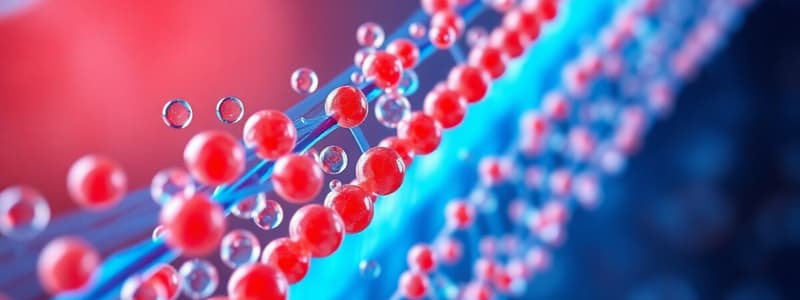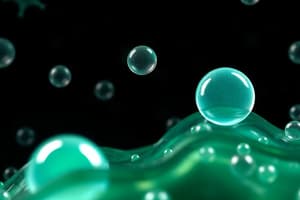Podcast
Questions and Answers
What is a key property of membranes that makes them essential in cell biology?
What is a key property of membranes that makes them essential in cell biology?
- Membranes consist only of proteins.
- Membranes are rigid structures.
- Membranes are impermeable to all substances.
- Membranes can act as selective barriers. (correct)
What allows lipids to assemble into a bilayer membrane?
What allows lipids to assemble into a bilayer membrane?
- Their electrical charge.
- Their amphiphilic chemical properties. (correct)
- Their ability to form hydrogen bonds.
- Their high molecular weight.
Which class of molecules is typically most permeable through lipid bilayers?
Which class of molecules is typically most permeable through lipid bilayers?
- Charged molecules
- Ions
- Small nonpolar molecules (correct)
- Large polar molecules
In which type of cells are membrane-bound organelles found?
In which type of cells are membrane-bound organelles found?
What is the thickness of a typical membrane?
What is the thickness of a typical membrane?
What is the primary function of the plasma membrane in relation to water-soluble molecules?
What is the primary function of the plasma membrane in relation to water-soluble molecules?
Which statement accurately describes the composition of the plasma membrane?
Which statement accurately describes the composition of the plasma membrane?
What characterizes membrane lipids, specifically phospholipids?
What characterizes membrane lipids, specifically phospholipids?
What is the charge of most lipids in cell membranes?
What is the charge of most lipids in cell membranes?
Which of the following roles is NOT a function of the plasma membrane?
Which of the following roles is NOT a function of the plasma membrane?
What forms the basic structure of cell membranes?
What forms the basic structure of cell membranes?
What is the primary factor affecting membrane fluidity?
What is the primary factor affecting membrane fluidity?
How does the presence of cholesterol affect membrane permeability?
How does the presence of cholesterol affect membrane permeability?
Which term describes the lateral movement of lipids within a membrane?
Which term describes the lateral movement of lipids within a membrane?
What is a major function of transmembrane proteins?
What is a major function of transmembrane proteins?
What role do scramblases play in membrane biology?
What role do scramblases play in membrane biology?
What happens to membrane fluidity with an increase in saturated lipids?
What happens to membrane fluidity with an increase in saturated lipids?
Which of the following describes the asymmetry of the plasma membrane?
Which of the following describes the asymmetry of the plasma membrane?
What is the primary consequence of having shorter fatty acid tails in membrane lipids?
What is the primary consequence of having shorter fatty acid tails in membrane lipids?
Which method assesses the mobility of proteins within membranes?
Which method assesses the mobility of proteins within membranes?
Peripheral membrane proteins interact with the membrane via which method?
Peripheral membrane proteins interact with the membrane via which method?
What effect does increasing the ratio of unsaturated to saturated lipids have on membrane properties?
What effect does increasing the ratio of unsaturated to saturated lipids have on membrane properties?
How is phospholipid asymmetry generated in the cell membrane?
How is phospholipid asymmetry generated in the cell membrane?
Flashcards
What are membranes made of?
What are membranes made of?
Cell membranes are primarily composed of a phospholipid bilayer, a double layer of phospholipid molecules. These molecules have a hydrophilic (water-loving) head and a hydrophobic (water-fearing) tail. The hydrophilic heads face outwards, interacting with the watery environment inside and outside the cell, while the hydrophobic tails face inwards, creating a barrier to water-soluble molecules.
What is the function of a membrane?
What is the function of a membrane?
Cell membranes act as selective barriers, controlling the movement of molecules in and out of the cell. They allow some molecules to pass through freely while others require specialized transport mechanisms. This selective permeability is crucial for maintaining the cell's internal environment and carrying out essential functions.
What are the properties of membranes?
What are the properties of membranes?
Membranes are dynamic structures that are constantly changing and adapting to the cell's needs. They are fluid, meaning the phospholipids can move within the bilayer, allowing for flexibility and reorganizing. They are also selectively permeable, controlling what molecules can cross them, crucial for maintaining cellular homeostasis.
What are membrane proteins?
What are membrane proteins?
Signup and view all the flashcards
Why is the phospholipid bilayer important?
Why is the phospholipid bilayer important?
Signup and view all the flashcards
What defines a eukaryotic cell?
What defines a eukaryotic cell?
Signup and view all the flashcards
Why are membranes important for cell function?
Why are membranes important for cell function?
Signup and view all the flashcards
What are membranes composed of?
What are membranes composed of?
Signup and view all the flashcards
What is the structure of phospholipids?
What is the structure of phospholipids?
Signup and view all the flashcards
What's the net charge of most cell membranes?
What's the net charge of most cell membranes?
Signup and view all the flashcards
What forms the basis of cell membranes?
What forms the basis of cell membranes?
Signup and view all the flashcards
What is the significance of the phospholipid bilayer's structure?
What is the significance of the phospholipid bilayer's structure?
Signup and view all the flashcards
What does 'fluidity' refer to in membrane context?
What does 'fluidity' refer to in membrane context?
Signup and view all the flashcards
How does saturation affect membrane fluidity?
How does saturation affect membrane fluidity?
Signup and view all the flashcards
What are other factors influencing membrane fluidity?
What are other factors influencing membrane fluidity?
Signup and view all the flashcards
What is the role of cholesterol in membranes?
What is the role of cholesterol in membranes?
Signup and view all the flashcards
How is membrane asymmetry established?
How is membrane asymmetry established?
Signup and view all the flashcards
Where does phospholipid synthesis occur?
Where does phospholipid synthesis occur?
Signup and view all the flashcards
What is the role of the Golgi apparatus in membrane asymmetry?
What is the role of the Golgi apparatus in membrane asymmetry?
Signup and view all the flashcards
What are the main categories of membrane proteins?
What are the main categories of membrane proteins?
Signup and view all the flashcards
How do integral membrane proteins interact with the membrane?
How do integral membrane proteins interact with the membrane?
Signup and view all the flashcards
How can multiple α-helices form pores?
How can multiple α-helices form pores?
Signup and view all the flashcards
What is FRAP and how is it used?
What is FRAP and how is it used?
Signup and view all the flashcards
What are the major functions of membrane proteins?
What are the major functions of membrane proteins?
Signup and view all the flashcards
Study Notes
Membrane Structure
- Membranes are crucial in cell biology. They define the boundaries and compartments within cells
- Lipids form bilayers, enabling membrane assembly. The chemical properties of lipids allow them to self-assemble into a bilayer structure.
- Lipid bilayers exhibit varying permeabilities to different molecules, as dictated by properties of the molecules themselves.
- Animations can visually demonstrate diffusion rates in GFP-tagged membrane proteins using FRAP (Fluorescence Recovery After Photobleaching).
- FRAP is a technique for analyzing protein diffusion within cell membranes.
- Eukaryotic cells have membrane-bound organelles, like mitochondria, peroxisomes, Golgi apparatus, lysosomes, and the endoplasmic reticulum, in addition to the plasma membrane.
Membrane Components
- Membranes are composed mainly of proteins and lipids, roughly 50% each, by mass.
- Membrane lipids are "amphipathic", having both hydrophilic (water-loving) heads and hydrophobic (water-fearing) tails
- Phospholipids are the most abundant lipid type in membranes, having a phosphate group in the hydrophilic head.
- Phospholipids assemble into a bilayer in water due to the hydrophobic effect.
- The membrane bilayer is asymmetric, with different types of phospholipids and proteins concentrated in each half of the bilayer.
Membrane Characteristics
- The fluid mosaic model describes the dynamic arrangement of proteins and lipids in membranes, enabling lateral diffusion
- Membranes function as selective barriers, regulating passage of substances.
- Phospholipid bilayers prevent water-soluble molecules from easily passing through. Small hydrophobic molecules and some small polar molecules can pass more readily.
- Membrane fluidity is influenced by factors like temperature, fatty acid tail length, the ratio of saturated to unsaturated lipids, and cholesterol content.
- Higher temperatures generally correspond to higher fluidity, and higher cholesterol content generally corresponds to lower fluidity.
Membrane Proteins
- Membrane proteins have various functions, including transport, signaling, and enzymatic activity
- Integral proteins span the membrane, often having hydrophobic regions embedded in the lipid bilayer. Other integral proteins can be attached to the monolayers or linked by lipids.
- Peripheral proteins are loosely associated with the membrane surface. They may bind directly to the hydrophilic parts of the bilayer.
- Integral proteins may cross the membrane as α-helices, and these proteins' hydrophobic amino acid side chains interact with hydrophobic lipid tails. Multiple α-helices can form hydrophilic pores within the membrane, allowing movement of polar or charged molecules.
- Protein diffusion within membranes can be restricted by interactions with the cell cortex, extracellular matrix, or other proteins on adjacent cells. Specific proteins can help facilitate the diffusion restriction.
Measurement of Protein Mobility
- FRAP (Fluorescence Recovery After Photobleaching) is a technique to determine protein mobility within the membrane. FRAP experiments typically involve tagging membrane proteins with a fluorescent protein like GFP, followed by photobleaching a portion of the membrane, and then observing how fluorescence is restored over time.
Studying That Suits You
Use AI to generate personalized quizzes and flashcards to suit your learning preferences.



